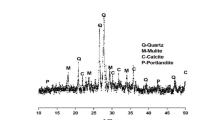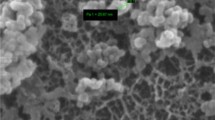Abstract
Ultrafine fly ash was added in the concrete mixtures in two different replacement ratios: 20 and 35 % in comparison with the control group. The water–to-binder ratio was 0.28. Standard curing and temperature matching curing methods were applied. Results showed that ultrafine fly ash decreased the adiabatic temperature rise of concrete and the bigger the replacement ratio, the more the decrease. It also decreased early compressive strength of concrete under standard curing condition, but it was compensated under temperature matching curing condition. Resistance to permeability of concrete was enhanced by ultrafine fly ash because the pore structure was improved. TG test reveals that the nucleation effect of ultrafine fly ash accelerated cement hydration. Temperature matching curing promoted the pozzolanic reaction of ultrafine fly ash at the early age. Non-evaporable water content was increased by ultrafine fly ash incorporation under standard curing condition, while at later age, under temperature matching curing condition it reduced the non-evaporable water content.






















Similar content being viewed by others
References
Wang Q, Yan PY, Feng JJ. Design of high-volume fly ash concrete for a massive foundation slab. Mag Concr Res. 2013;65(2):71–81.
Yen T, Hsu TH, Liu YW, Chen SH. Influence of class F fly ash on the abrasion-erosion resistance to high strength concrete. Constr Build Mater. 2007;21:458–63.
Naik TR, Singh SS, Hossain MM. Abrasion resistance to high strength concrete made with class C fly ash. ACI Mater J. 1995;92(6):559–65.
Poon CS, Lam L, Wong YL. A study on high strength concrete prepared with large volume of low calcium fly ash. Cem Concr Res. 2000;30:447–55.
Kayali O, Zhu B. Chloride induced reinforcement corrosion in lightweight aggregate high-strength fly ash concrete. Constr Build Mater. 2005;19:327–36.
Nath P, Sarker P. Effect of fly ash on the durability properties of high strength concrete. Procedia Eng. 2011;14:1149–56.
Jaturapitakkul C, Kiattikomol K, Sata V, Leekeeratikul T. Use of ground coarse fly ash as a replacement of condensed silica fume in producing high-strength concrete. Cem Concr Res. 2004;34:549–55.
Chindaprasirt P, Jaturapitakkul C, Sinsiri T. Effect of fly ash fineness on compressive strength and pore size of blended cement paste. Cem Concr Compos. 2005;27:425–8.
Chindaprasirt P, Homwuttiwong S, Sirivivatnanon V. Influence of fly ash fineness on strength, drying shrinkage and sulfate resistance to blended cement mortar. Cem Concr Res. 2004;34:1087–92.
Chindaprasirt P, Chotithanorm C, Cao HT, Sirivivatnannon V. Influence of fly ash fineness on the chloride penetration of concrete. Constr Build Mater. 2007;21:356–61.
Kiattikomol K, Jaturapitakkul C, Songpiriyakij S, Chutubtim S. A study of ground coarse fly ashes with different finenesses from various sources as pozzolanic materials. Cem Concr Compos. 2001;23:335–43.
Haque MN, Kayali O. Properties of high-strength concrete using a fine fly ash. Cem Concr Res. 1998;28:1445–52.
Subramaniam KV, Gromotka R, Shah SP, Obla K, Hill R. Influence of ultrafine fly ash on the early age response and the shrinkage cracking potential of concrete. J Mater Civil Eng. 2005;17:45–53.
Chindaprasirt P, Jaturapitakkul C, Sinsiri T. Effect of fly ash fineness on microstructure of blended cement paste. Constr Build Mater. 2007;21:1534–41.
Termkhajornkit P, Barbarulo R. Modeling the coupled effects of temperature and fineness of Portland cement on the hydration kinetics in cement paste. Cem Concr Res. 2012;42(3):526–38.
Atiş CD. Heat evolution of high-volume fly ash concrete. Cem Concr Res. 2002;32(5):751–6.
Kjellsen KO, Detwiler RJ. Reaction-kinetics of Portland-cement mortars hydrated at different temperatures. Cem Concr Res. 1992;22(1):112–20.
Wang Q, Yan PY, Yang JW, Zhang B. Influence of steel slag on mechanical properties and durability of concrete. Constr Build Mater. 2013;47:1414–20.
Escalante-Garcıa JI, Sharp JH. The microstructure and mechanical properties of blended cements hydrated at various temperatures. Cem Concr Res. 2001;31(5):695–702.
Wang Q, Miao M, Yan PY. The influence of high-temperature curing on the hydration characteristics of a cement-GGBS binder. Adv Cem Res. 2012;24(1):33–40.
Metha PK. Durability: critical issues for the future. Concr Int. 1997;19(7):27–33.
Supit SWM, ShaikhFaiz UA, Sarker PK. Effect of ultrafine fly ash on mechanical properties of high volume fly ash mortar. Constr Build Mater. 2014;51:278–86.
Deschner F, Lothenbach B, Winnefeld F, Neubauer J. Effect of temperature on the hydration of Portland cement blended with siliceous fly ash. Cem Concr Res. 2013;52:169–81.
Narmluk M, Nawa T. Effect of fly ash on the kinetics of Portland cement hydration at different curing temperatures. Cem Concr Res. 2011;41:579–89.
Wang Q, Li MY, Jiang GH. The difference among the effects of high-temperature curing on the early hydration properties of different cementitious systems. J Therm Anal Calorim. 2014;118(1):51–8.
Lu P, Sun G, Yong JF. Phase composition of hydrated DPS cement pastes. J Am Ceram Soc. 1993;76(4):1003–7.
Gómez-Zamorano LY, Escalante-García J. Effect of curing temperature on the non evaporable water in Portland cement blended with geothermal silica waste. Cem Concr Compos. 2010;32:603–10.
Escalante-Garcia JI. Non evaporable water from neat OPC and replacement materials in composite cements hydrated at different temperatures. Cem Concr Res. 2003;33:1883–8.
Acknowledgements
Authors acknowledge the support from Shandong Provincial Natural Science Foundation, China (ZR2012EEQ014), and Youth Science and Technology Innovation Project of Shandong Agricultural University.
Author information
Authors and Affiliations
Corresponding author
Rights and permissions
About this article
Cite this article
Feng, J., Liu, S. & Wang, Z. Effects of ultrafine fly ash on the properties of high-strength concrete. J Therm Anal Calorim 121, 1213–1223 (2015). https://doi.org/10.1007/s10973-015-4567-3
Received:
Accepted:
Published:
Issue Date:
DOI: https://doi.org/10.1007/s10973-015-4567-3




